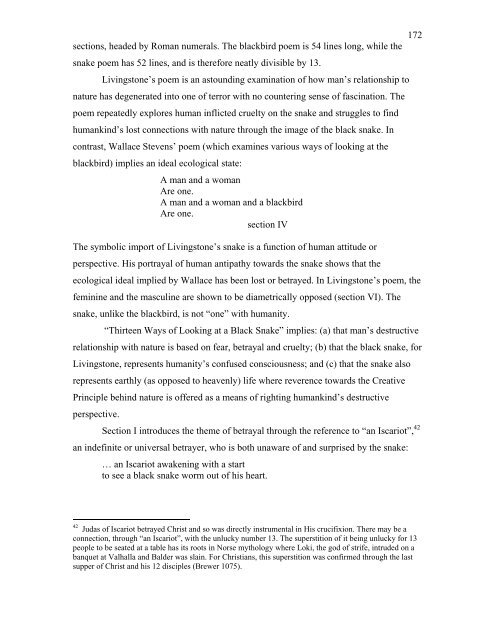"Symbiosis or Death": - Rhodes University
"Symbiosis or Death": - Rhodes University
"Symbiosis or Death": - Rhodes University
You also want an ePaper? Increase the reach of your titles
YUMPU automatically turns print PDFs into web optimized ePapers that Google loves.
172<br />
sections, headed by Roman numerals. The blackbird poem is 54 lines long, while the<br />
snake poem has 52 lines, and is theref<strong>or</strong>e neatly divisible by 13.<br />
Livingstone’s poem is an astounding examination of how man’s relationship to<br />
nature has degenerated into one of terr<strong>or</strong> with no countering sense of fascination. The<br />
poem repeatedly expl<strong>or</strong>es human inflicted cruelty on the snake and struggles to find<br />
humankind’s lost connections with nature through the image of the black snake. In<br />
contrast, Wallace Stevens’ poem (which examines various ways of looking at the<br />
blackbird) implies an ideal ecological state:<br />
A man and a woman<br />
Are one.<br />
A man and a woman and a blackbird<br />
Are one.<br />
section IV<br />
The symbolic imp<strong>or</strong>t of Livingstone’s snake is a function of human attitude <strong>or</strong><br />
perspective. His p<strong>or</strong>trayal of human antipathy towards the snake shows that the<br />
ecological ideal implied by Wallace has been lost <strong>or</strong> betrayed. In Livingstone’s poem, the<br />
feminine and the masculine are shown to be diametrically opposed (section VI). The<br />
snake, unlike the blackbird, is not “one” with humanity.<br />
“Thirteen Ways of Looking at a Black Snake” implies: (a) that man’s destructive<br />
relationship with nature is based on fear, betrayal and cruelty; (b) that the black snake, f<strong>or</strong><br />
Livingstone, represents humanity’s confused consciousness; and (c) that the snake also<br />
represents earthly (as opposed to heavenly) life where reverence towards the Creative<br />
Principle behind nature is offered as a means of righting humankind’s destructive<br />
perspective.<br />
Section I introduces the theme of betrayal through the reference to “an Iscariot”, 42<br />
an indefinite <strong>or</strong> universal betrayer, who is both unaware of and surprised by the snake:<br />
… an Iscariot awakening with a start<br />
to see a black snake w<strong>or</strong>m out of his heart.<br />
42 Judas of Iscariot betrayed Christ and so was directly instrumental in His crucifixion. There may be a<br />
connection, through “an Iscariot”, with the unlucky number 13. The superstition of it being unlucky f<strong>or</strong> 13<br />
people to be seated at a table has its roots in N<strong>or</strong>se mythology where Loki, the god of strife, intruded on a<br />
banquet at Valhalla and Balder was slain. F<strong>or</strong> Christians, this superstition was confirmed through the last<br />
supper of Christ and his 12 disciples (Brewer 1075).

















